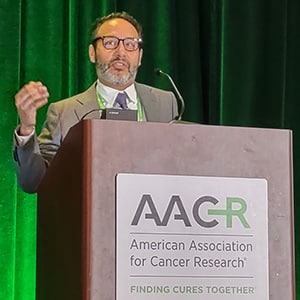Tobias Janowitz, MD, PhD, from Cold Spring Harbor Laboratory, opened up about his close personal experience with cancer cachexia at the AACR Special Conference in Cancer Research: Advances in Pancreatic Cancer Research. Shortly after beginning his research into the condition, he watched his late mother wither away from it.
He recalled a particularly poignant observation she made days before her death: “My body is used up.”
Cachexia is characterized by the significant, rapid weight loss and deterioration of muscle tissue that accompany many cancer diagnoses. Often, Janowitz explained, cachexia can be as dangerous as the cancer itself. Unfortunately, cachexia is remarkably common among patients with pancreatic cancer, a disease with a 12.8% five-year relative survival rate.
“A thing I often tell the fellows is that if the patient doesn’t have weight loss, then they don’t have pancreas cancer,” said conference co-chair Peter J. Allen, MD, of Duke University.
But a session at this year’s meeting cast the subject in a more hopeful light, complete with new insights into the mechanisms underlying pancreatic cancer cachexia and new treatment modalities that are inching closer to the clinic.
What Is Cachexia?
If the body is designed to fight back against disease, why does it waste away when confronted with cancer? It makes sense from an evolutionary perspective, explained Teresa A. Zimmers, PhD, of the Oregon Health & Science University Knight Cancer Institute. When mammals don’t feel well, we typically become lethargic and uninterested in food or other things that bring us pleasure. This, Zimmers said, is an evolutionary adaptation to protect ourselves from predation and prevent the spread of contagion to others.
Often, the body reacts before we’re consciously aware of the problem. Unexplained weight loss is a common symptom that leads to a diagnosis of pancreatic cancer; in fact, individuals presenting to the clinic with unexplained weight loss are around three times more likely to be diagnosed with pancreatic cancer than the general population.
But weight loss isn’t the only complication of cachexia. The condition also involves the wasting of muscle and adipose tissue, which can also precede a diagnosis of pancreatic cancer by months to years. Cardiac muscle can also be affected, leading to impaired heart function. Other studies have shown systemic disruptions to the immune system in patients with cachexia, which can stymie responses to immunotherapies such as immune checkpoint inhibitors.
At the molecular level, Zimmers is particularly interested in the role of the inflammatory cytokine interleukin-6 (IL-6) in driving cancer cachexia through a variety of cellular signaling pathways. She and her colleagues performed a phase II clinical trial testing the standard-of-care chemotherapies nab-paclitaxel and gemcitabine, with and without the IL-6-targeting antibody tocilizumab, as a first-line treatment in patients with advanced pancreatic cancer. Although the addition of tocilizumab did not impact progression or survival, it did significantly decrease the amount of skeletal muscle lost.
A Full-body Disease
How can so many independent processes be coordinated to form the complex phenotype of cachexia? Janowitz wasn’t surprised to learn that the brain was involved.
“Cachexia, in no small part, is a behavioral condition,” Janowitz said. “I would like to submit that behavior is mostly orchestrated by the brain, and so it makes sense to look in the brain for the mechanisms that drive cachexia.”
The upregulated IL-6 signaling observed in cachexia can influence brain function by suppressing activity in areas related to pleasure seeking and hormone sensing, Janowitz explained. He and his colleagues showed that delivery of an IL-6-blocking antibody into the brains of cachectic mice could reverse full-body symptoms of cachexia, including weight loss and decreased food intake.

In behavioral experiments, mice with cachexia were less persistent in tasks related to food and water foraging. Using a fluorescent reporter that responds to dopamine, the researchers showed that cachectic mice experienced less dopamine release upon earning a reward than did mice without cachexia.
“I really think that cancer neuroscience in the broader sense … the connectivity of the central nervous system, through the endocrine system and the inflammatory system, with the tumor … is an area where a lot can be discovered,” Janowitz said.
Janowitz and colleagues also showed that mice with cachexia had an unusual response to metabolic stress. Instead of undergoing ketogenesis to produce energy during starvation, cachectic mice produced a massive inflammatory response that could contribute to immune suppression.
New Treatments Offer Hope
Andrew E. Hendifar, MD, MPH, of Cedars-Sinai Medical Center, began his presentation with a rare message of hope for the field. “Usually when I give a talk on clinical trials in cancer cachexia, I talk about why the trials are negative,” he said. “Today, fortunately, is going to be a different type of talk.”
Hendifar explained that interventions for cancer cachexia are incredibly limited, with only dietary counseling, progesterone analogs, and short-term corticosteroid treatment being recommended by consensus guidelines. Further, clinical trials to test new interventions face design challenges in terms of disease scope, the confounding effects of different cancer treatments, and an optimal endpoint to demonstrate that an intervention “works.” It is partially for this reason, he argued, that clinically meaningful improvements have been difficult to demonstrate.

Nevertheless, he discussed three recent trials moving the needle forward. The MENAC clinical trial tested a multipronged approach to treat cachexia in patients with lung or pancreatic cancer. The intervention consisted of nutritional counseling, exercise, ibuprofen, and omega-3 fatty acid supplements on top of standard cancer therapy. While patients who received the intervention did not gain weight during the trial, they lost significantly less weight than patients receiving cancer treatment alone.
Since ibuprofen has shown hints of efficacy against cachexia, another trial tested a stronger nonsteroidal anti-inflammatory drug (NSAID), ketorolac, in patients with pancreatic cancer and cachexia. Preliminary results showed that a five-day course of ketorolac could increase body mass and steps per day in some patients.
But the most notable news came in the form of a study published the day before the meeting began. In a phase II clinical trial, researchers found that a drug targeting the protein GDF15 could induce weight gain in patients with cachexia—the first time in quite a while that such a benchmark has been reached, Hendifar said.
GDF15 is a cellular stress response protein that is secreted by some fat, muscle, tumor, and immune cells in a variety of physiological stress conditions, including cancer, pregnancy, and tissue injury. Preliminary data showed that GDF15 levels are high in patients with pancreatic cancer and cachexia, and the investigational GDF15-targeting antibody ponsegromab may help stabilize their weight.
Among patients with lung, colorectal, or pancreatic cancer cachexia and high levels of GDF15, increasing doses of ponsegromab increased placebo-adjusted changes in body mass, up to a median of 3 kg at the highest dose level. Patients receiving the highest dose of ponsegromab also noted improvements in patient-reported symptom scores and non-sedentary physical activity.
“To conclude, 2024 has been very kind for the therapeutic development in cancer cachexia,” Hendifar said. “I’m really pleased to be able to present some positive data for the first time in a while.”


